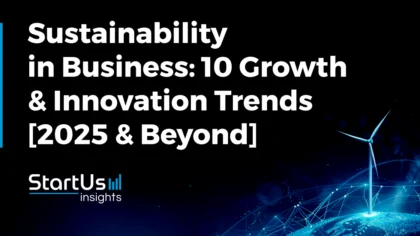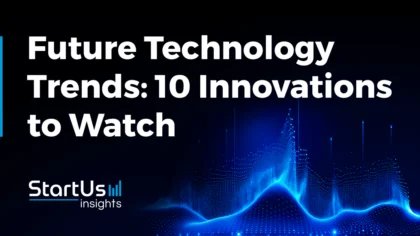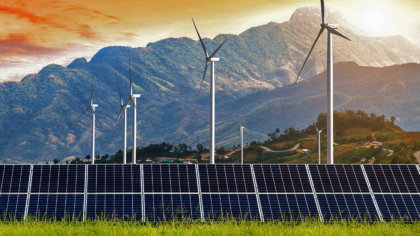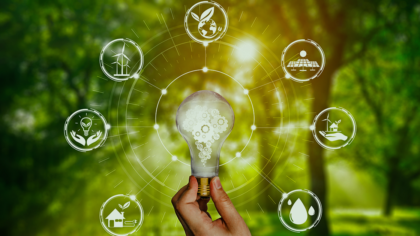Accelerate Productivity in 2025
Reignite Growth Despite the Global Slowdown
Sustainability in business is a critical driver of long-term growth, competitive advantage, and risk mitigation across industries. Moreover, environmental, social, and governance (ESG) considerations influence consumer behavior, investment decisions, and regulatory landscapes. That is why companies that embrace sustainable practices are able to position themselves for success.
This practical guide on sustainability for business explores 10 key sustainable technologies and promising startups, challenges of implementation, and future roadmap. These actionable, data-driven insights allow you to navigate the future of sustainability for your business effectively.
This article was last updated in January 2025.

Executive Summary
- How Sustainability Impacts Your Business
- Profitability: The sustainability sector has experienced a 176.76% funding growth over the past five years, reaching USD 2.1 trillion.
- Investor Demand: With over 23 000 investors in sustainability-driven companies, investment confidence is high. Top investors are Techstars, Y Combinator, and Google for Startups.
- Market Trends: Global interest in sustainability has surged by 147.8% in the last five years, reflecting consumer preference for sustainable products.
- Key Sustainability Technologies Reshaping Industries
- Overcoming Challenges
- Initial Investment: Implementing sustainable strategies involves high upfront costs but businesses gain long-term ROI through reduced energy and operational costs.
- Regulatory Compliance: Companies face challenges in navigating complex and varying sustainability regulations across regions. Leveraging tech-driven solutions allows businesses to maintain compliance.
- Measuring Impact: Measuring sustainability initiatives’ impact is difficult but essential for tracking progress. Utilizing standardized frameworks ensures accountability and transparency.
- Future of Green Technology
- Evolving Consumer Expectations: Increasing demand for eco-friendly products drives companies to adopt sustainable practices.
- The Rise of Green Technologies: Hydrogen fuel cells, CCUS, smart grids, and more enhance energy efficiency, reduce carbon emissions, and optimize resource management.
- Regulatory Shifts: Policies like the European Union’s Green Deal highlight the need for compliance and investment in sustainability to meet climate goals.
How We Researched and Where this Data is from
- Analyzed our 3100+ industry reports on sustainability innovations to gather relevant insights.
- Cross-checked this information with external sources for enhanced accuracy.
- Leveraged the StartUs Insights Discovery Platform, an AI- and Big Data-powered innovation intelligence platform covering 4.7M+ emerging companies and over 20K+ technology trends worldwide, to:
- Confirm our findings using the trend analysis tool and
- Identify companies for “Spotlighting an Innovator” sections.
How Sustainability Impacts Your Business
Profitability
With more than 384 000 businesses engaged in sustainable technologies and ESG initiatives, the market demonstrates a strong commitment to this movement. Over the past five years, the sector has seen a remarkable funding growth of 176.76%, totaling investments to USD 2.1 trillion. This demonstrates the enormous financial support that sustainability-focused organizations receive.
The average funding round amounts to USD 54.7 M, indicating that investors see a high potential return on investment in sustainability-related ventures. Companies working in the sustainability domain optimize resource usage and minimize waste. This directly translates to reduced operational costs and, in turn, increased profit margins.
Moreover, sustainability drives innovation in product development and service delivery by rethinking traditional processes and products that meet emerging customer needs. This opens up additional revenue streams.
Investor Demand
Sustainability is at the forefront of investment strategies, with over 23 000 investors funding sustainability-driven companies. Notably, top investors such as Techstars have invested USD 47.9 million in 281 companies, Y Combinator has invested USD 117.2 million in 97 companies, and Google for Startups has supported 82 companies with USD 1.3 million.
The average invested sum per investor stands at USD 22.2 million. This demonstrates the high level of confidence in sustainability as a profitable investment opportunity. As a result, companies committed to sustainable practices are able to attract more funding opportunities and strengthen their market position.
Companies with strong sustainability performance often enjoy better access to capital as they are perceived to be forward-thinking and less susceptible to regulatory fines, reputational damage, or resource scarcity. Therefore, companies that prioritize sustainability may benefit from increased stock valuations.
Market Trends
The visibility and interest in sustainability continue to surge, with global search growth reaching 147.8% over the last five years. This trend reflects an increasing consumer preference for sustainable products and services. Consequently, companies integrate sustainability into their core business strategies to address this growing consumer demand.
News coverage around sustainability has also grown by 13.12% in the past five years. This indicates heightened awareness and discussion around the topic. As a result, companies that invest in sustainability are more likely to capture market share, increase brand loyalty, and expand their customer base.
Businesses that align with these values will be able to differentiate themselves in the market and this leads to increased customer loyalty and market share. Companies that transparently communicate their sustainability efforts often experience enhanced brand reputation and customer trust. Because of the perceived increased value by customers, businesses are able to increase sales and leverage premium pricing schemes.
Key Sustainability Technologies Reshaping Industries in 2025 & Beyond

1. Renewable Energy
The global transition to sustainable power solutions is primarily driven by renewable energy to reduce carbon emissions, improve energy security, and promote long-term economic growth.
Renewable energy sources, such as solar, wind, hydro, and bioenergy, provide abundant, clean, and sustainable power alternatives to fossil fuels. This enables communities, businesses, and entire economies to achieve environmental sustainability and energy independence.
Financial Forecast for Renewable Energy
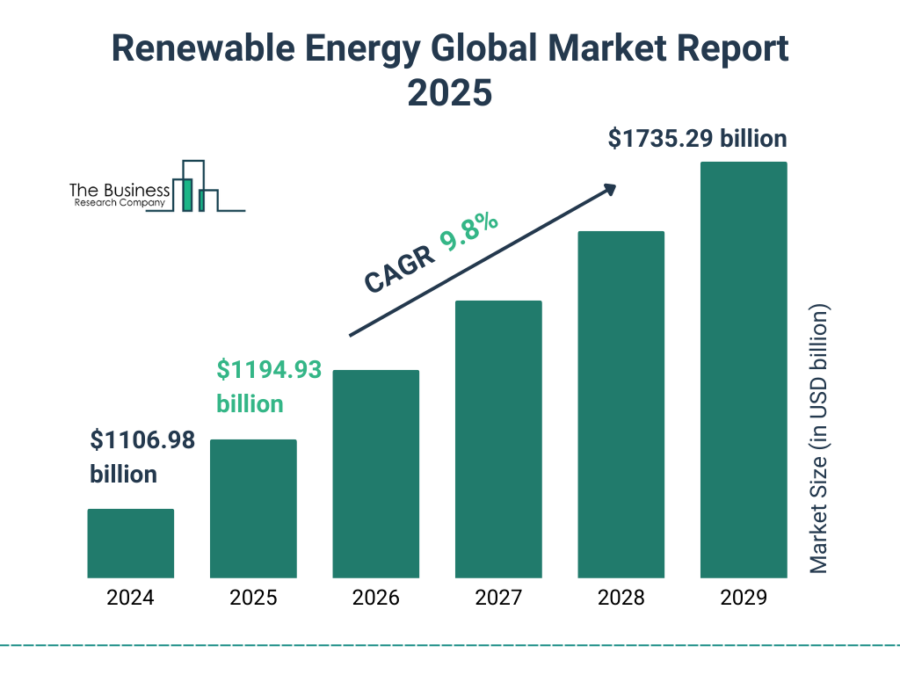
Source: The Business Research Company
- 2025: The Business Research Company predicts a global renewable energy investment of USD 1.19 trillion.
- 2025-2029:
- A compound annual growth rate (CAGR) of 9.8%.
- The renewable energy market value is to reach USD 1.73 trillion by 2033.
Practical Use Cases of Renewable Energy
- Industrial Energy Supply: Manufacturing facilities and heavy industries integrate on-site solar and wind power. This reduces dependence on traditional power grids, energy costs, and their carbon footprint.
- Green Data Centers: The exponential growth of data generation is surging the energy consumption of data centers. Tech giants like Google and Microsoft have made substantial investments to power their data centers with renewable energy.
- Renewable Energy in Agriculture: Powers irrigation systems, greenhouses, and processing equipment. Solar-powered water pumps, for example, enable farmers to efficiently irrigate crops in remote areas without relying on the grid.
Core Technologies Connected to Renewable Energy
- Photovoltaic (PV) Technology: Solar panels convert sunlight directly into electricity. Advances in PV are bifacial solar panels and thin-film cells that increase energy conversion efficiency.
- Wind Turbines: Harness kinetic energy from wind to generate electricity. Larger rotor diameters and advanced blade materials improve energy capture even in low-wind conditions.
- Battery Energy Storage Systems (BESS): Store surplus energy generated by renewable sources like solar and wind. Lithium-ion and solid-state batteries enable reliable energy storage and delivery.
- Smart Grids: Sensors, advanced analytics, and automation facilitate the integration of renewable energy into existing power networks. This enables real-time monitoring and efficient distribution.
Noteworthy Renewable Energy Advancements
- Orsted’s Offshore Wind Farms: Its Hornsea One project in the UK generates over 1.2 GW of clean energy – enough to power more than one million homes. The company uses advanced turbine technology and large-scale offshore wind infrastructure.
- Tesla’s Solar Roof: Integrates solar energy generation with traditional roofing materials to reduce electricity bills and allows homeowners to generate clean energy.
- Siemens Gamesa’s Renewable Hydrogen Production: Uses wind energy to power electrolysis processes that split water into hydrogen and oxygen. This green hydrogen is used to decarbonize sectors that are traditionally difficult to electrify.
Spotlighting an Innovator: P-layer
P-layer is a French startup that develops a self-powered photovoltaic dynamic glass. It combines semiconductors and liquid crystals to modulate light while generating electricity. The company’s patented technology automatically adjusts light intensity and offers fast, localized control.
The glass functions without an external power supply and supports electricity production to enhance energy efficiency. Consequently, the company’s technology improves energy optimization and environmental responsibility across sectors like transportation, building management, agriculture, and more.
2. Energy Storage
To fully utilize renewable energy, energy storage equipment such as flywheels, compressed air, and sophisticated batteries are necessary. By storing excess energy at times of high production and releasing it during times of low generation or peak demand, they mitigate the intermittency of renewable energy sources like solar and wind.
This way, energy storage solutions increase energy efficiency, strengthen grid resilience, and reduce reliance on conventional power sources.
Financial Forecast for Energy Storage
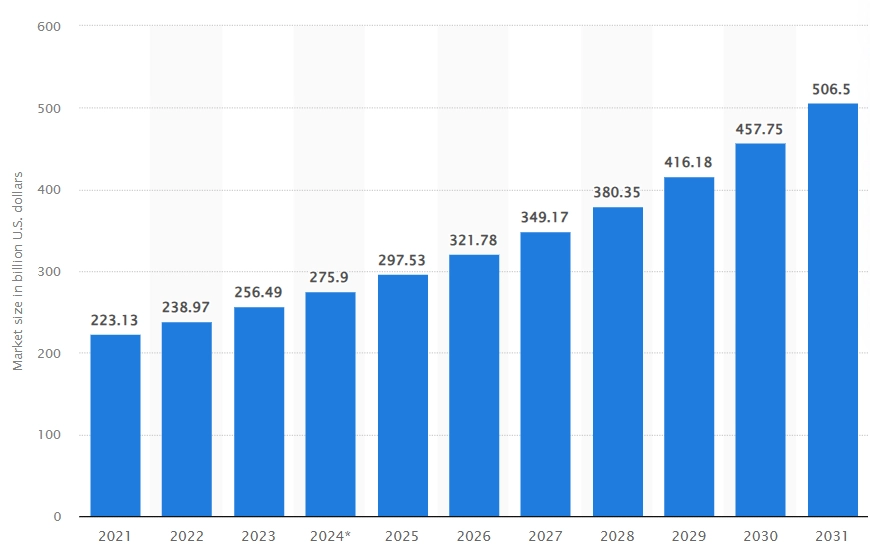
Source: Statista
- 2025: Statista forecasts a global energy storage systems investment of USD 297.53 billion.
- 2025-2031:
- A CAGR of 9.07%.
- Energy storage systems market value to reach USD 506.5 billion by 2031.
Practical Use Cases of Energy Storage
- Grid Stability & Peak Shaving: Energy storage systems stabilize the grid by storing excess electricity generated during low-demand periods. This stored energy is then released during peak demand to reduce the strain on the grid and ensure a stable power supply.
- Renewable Energy Integration: Energy storage technologies enable the integration of renewable energy by addressing their intermittent nature. For example, solar energy stored during sunny periods is used at night to ensure a continuous clean energy supply.
- Backup Power for Critical Infrastructure: Energy storage systems provide reliable backup power for critical infrastructure, such as hospitals, data centers, and manufacturing facilities, during power outages or emergencies.
Core Technologies Connected to Energy Storage
- Lithium-Ion Batteries: Offer high energy density, efficiency, and a long cycle life, making them ideal for applications in electric vehicles, portable electronics, and grid storage systems.
- Solid-State Batteries: Enhance energy density, safety, and overall performance by enabling longer battery life and faster charging times. These qualities make them suitable for EVs and portable devices.
- Flow Batteries: Store energy in external tanks of liquid electrolytes to provide long-duration energy storage and manage fluctuations in energy demand efficiently.
- Hydrogen Fuel Cells: Function both as an energy storage medium and a power generation source by converting stored hydrogen into electricity.
Noteworthy Energy Storage Advancements
- Tesla’s Innovative Batteries: Powerwall, Powerpack, and Megapack products cater to residential, commercial, and utility-scale applications. They provide reliable and efficient energy storage solutions. Tesla’s Megapack, for instance, is designed for large-scale projects and can store over 3 MWh of energy.
- Siemens and AES’ Joint Venture: Fluence offers a range of energy storage products for grid-scale systems, renewable integration, and frequency regulation.
- Energy Vault’s Gravity-based Energy Storage: Uses cranes to lift heavy blocks to store potential energy that is converted back into electricity when needed. This method offers a sustainable alternative to traditional battery storage.
Spotlighting an Innovator: Cerebral Energy
Cerebral Energy is a US-based company that provides solid-state battery technology with excellent energy density and safety by utilizing sustainable, renewable, and lithium-free materials. The company’s batteries improve safety by removing dendritic heat-related problems while increasing power efficiency for uses like Low Earth Orbit satellites.
In order to create synthetic graphite, it recycles US carbon waste, lowering reliance on imported resources and promoting a sustainable supply chain. Cerebral Energy promotes environmental sustainability and energy independence while accelerating electrification through the provision of affordable, lightweight, and environmentally friendly batteries.
Further, the company was recently awarded a Phase II STTR follow-on contract worth USD 1.6 million by AFWERX. The contract supports its development of a lithium-free secondary battery utilizing recycled aluminum and graphene.
3. Circular Economy
To reduce the impact on the environment, the circular economy enables products with extended lifespans, repurposes waste materials, and minimizes resource exploitation.
Businesses that use circular principles also achieve lower costs, more efficient use of resources, and enhanced sustainability credentials. By implementing circular practices, businesses can turn waste into valuable inputs, extend product life cycles, and create new revenue streams.
Financial Forecast for Circular Economy
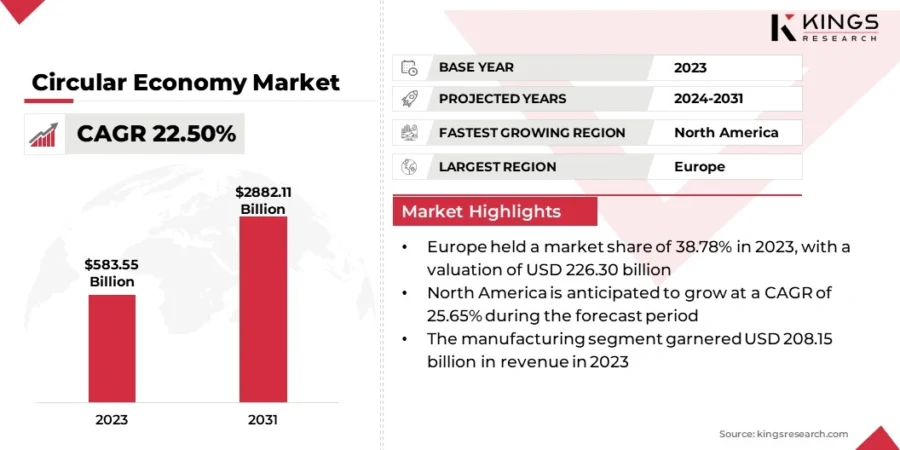
Source: Kings Research
- 2025: Kings Research expects a global circular economy investment of USD 696.19 billion.
- 2025-2031:
- A CAGR of 22.50%.
- Circular economy market value to reach USD 2.8 trillion by 2031.
Practical Use Cases of Circular Economy
- Product-as-a-Service Models: For example, some companies offer laundry services or lease the machines instead of selling washing machines. This model ensures products are returned to the manufacturer at the end of their life for refurbishing, recycling, or repurposing.
- Material Recycling & Upcycling: Fashion companies collect, process, and convert discarded clothing and textile waste into high-quality fibers for new garments. This approach reduces the need for virgin materials and reduces waste.
- Industrial Symbiosis: Waste or by-products from one company serve as raw materials for another. For instance, heat generated from a steel manufacturing plant can be used to provide heating for nearby greenhouses or residential areas.
Core Technologies Connected to Circular Economy
- Advanced Recycling Technologies: Convert waste materials into reusable resources through chemical recycling, pyrolysis, and gasification. This enables the creation of virgin-like materials from waste and diverts waste from landfills.
- Internet of Things (IoT) & Smart Sensors: Enable real-time tracking and monitoring of products, materials, and waste to provide valuable data on resource use, product wear and tear, and waste generation. This facilitates efficient resource management and maintenance.
- 3D Printing: Enables efficient production processes that generate less waste and allow for on-demand, localized manufacturing. Additionally, 3D printing enables the repair and customization of existing products and extends their lifespan.
- Blockchain: Provides an immutable record of transactions to enable materials, products, and waste tracking from their origin to their end-of-life. This traceability ensures that materials are sourced sustainably as well as recycled and reused efficiently.
Noteworthy Circular Economy Advancements
- Schneider Electric: Focuses on eco-design using recyclable materials and extending product life through refurbishment and repair services. The company’s 170 sites are achieving the Towards Zero Waste to Landfill label by reusing 94% of their waste.
- IKEA: Committed to becoming a fully circular business by 2030, the company is implementing several initiatives to promote product longevity and waste reduction, such as furniture take-back programs, leasing options, and resale of second-hand items.
- Patagonia: The company launched the Worn Wear program that encourages customers to repair, reuse, and recycle their garments. This initiative includes a repair service for damaged clothing and a trade-in option where customers receive store credits for used Patagonia items.
Spotlighting an Innovator: Recuro
Recuro is a Norwegian startup that offers a pyrolysis process that converts plastic waste into carbon, gas, and oil. Compared to traditional methods, its core induction heating technology ensures precise zone heating, minimizes heat loss, and improves output control. This leads to increased energy efficiency and lower emissions while upcycling plastic waste into useful materials.
4. Energy-Efficient Integrations
Energy-efficient integrations reduce energy consumption across industrial, commercial, and residential settings. Businesses leverage smart systems, advanced automation, and data analytics to optimize energy use, reduce waste, and lower operational costs.
These integrations include intelligent HVAC systems, LED lighting, and energy management software. Adopting energy-efficient solutions becomes both a strategic business decision and an environmental necessity as regulatory constraints and energy costs increase.
Financial Forecast for Energy-Efficient Integrations
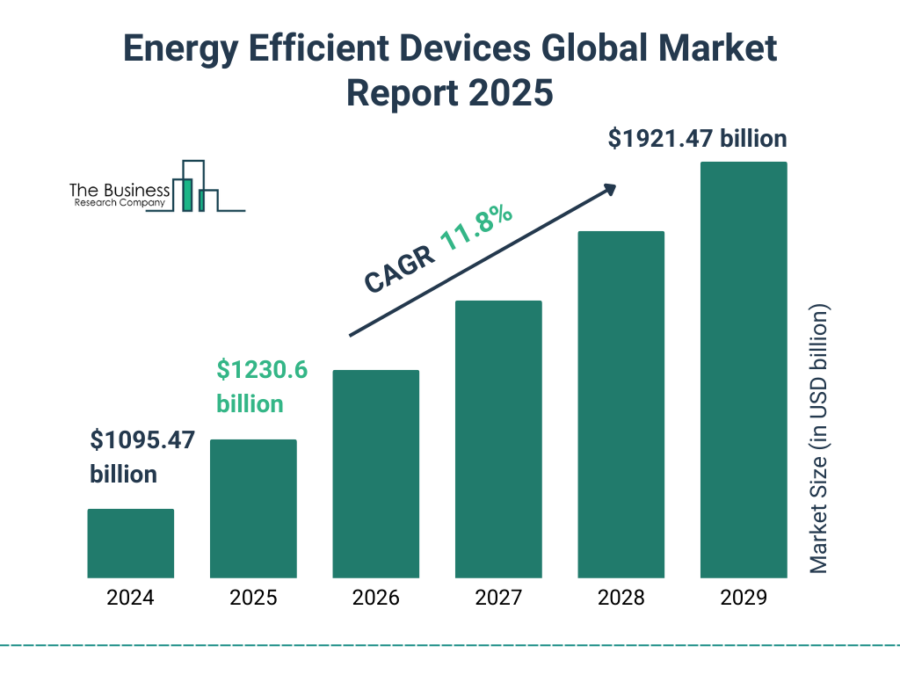
Source: The Business Research Company
- 2025: The Business Research Company predicts the global energy efficiency devices market to reach USD 1.23 trillion.
- 2025-2029:
- A CAGR of 11.8%.
- Energy efficiency devices market value to reach USD 1.92 trillion by 2030.
Practical Use Cases of Energy Efficiency Technologies
- Smart Building Management Systems: Use sensors, IoT devices, and AI to monitor and optimize energy use in real time. For example, intelligent lighting controls adjust brightness based on occupancy and natural light.
- Industrial Process Optimization: For instance, manufacturing plants use variable frequency drives (VFDs) to regulate the speed of motors based on demand. Additionally, waste heat recovery systems capture and convert excess heat into steam or electricity.
- Regenerative Braking: Converts kinetic energy created due to braking into electrical energy to be stored in the battery. This technology extends the driving range and reduces the frequency of recharging.
Core Technologies Connected to Energy-Efficient Integrations
- Smart Grids: Enable real-time monitoring, management, and optimization of electricity supply and demand. It utilizes advanced sensors, smart meters, and communication networks to provide a two-way flow of information between utilities and consumers.
- Building Automation Systems (BAS): Utilize sensors, controllers, and software to monitor and control HVAC and other building systems. By optimizing energy use based on occupancy, weather conditions, and usage patterns, BAS reduces energy consumption.
- Energy Management Systems (EMS): Connects various energy-consuming appliances, machinery, and infrastructure to a centralized energy management platform. The data can be analyzed to identify inefficiencies, predict maintenance needs, and optimize energy usage.
- Heat Recovery Systems: Convert waste heat generated from industrial processes, HVAC systems, or power generation into useful energy. This reduces the overall energy consumption required for heating, cooling, or power production.
Noteworthy Advancements in Energy-Efficient Integrations
- Siemens Energy: A leading company in the renewable energy storage sector that offers grid-scale batteries, flow batteries, and hydrogen storage. They ensure that surplus energy generated from renewable sources is stored efficiently and released during high demand.
- Schneider Electric: Heavily involved in the development of smart grid and energy management systems, it provides advanced sensors, real-time data analytics, and demand response systems to optimize energy distribution and enhance grid reliability.
- Oracle: Contributes to energy efficiency through its advanced software solutions. The company combines AI and behavioral science to preserve utility assets, lower costs, reduce outages, and enhance productivity.
Spotlighting an Innovator: Norm Technologies
Swiss startup Norm Technologies creates a digital platform that evaluates the energy efficiency, CO2 emissions, and renovation potential of buildings. The platform integrates into clients’ ecosystems to offer energy performance certificates, refurbishment roadmaps, and renovation calculations. With modular and auditable solutions, the company enables property managers, banks, and energy providers to conduct accurate energy assessments while improving cost savings and compliance with ESG standards.
5. Carbon Capture, Utilization and Storage
CCUS reduces carbon emissions and combats climate change by capturing CO2 emissions from industrial processes, power plants, or directly from the air. Once captured, the carbon is either stored underground in geological formations or used for creating building materials, fuels, or chemicals.
This approach to carbon reduction also allows hard-to-abate sectors like cement, steel, and chemicals to reduce their carbon footprint.
Financial Forecast for CCUS Technologies

Source: The Business Research Company
- 2025: The Business Research Company predicts the global CCUS market to reach USD 3.11 billion.
- 2025-2029:
- A CAGR of 14.4%.
- CCUS market value to reach USD 5.33 billion by 2030.
Practical Use Cases of CCUS
- Enhanced Oil Recovery (EOR): Captured CO2 is injected into aging oil fields to increase pressure and extract additional oil that would otherwise be inaccessible. This boosts oil recovery and permanently stores CO2 underground.
- Building Materials: Captured CO2 is used to produce eco-friendly construction materials like carbon-infused concrete. The carbon dioxide enhances concrete strength and durability while sequestering the carbon.
- Bioenergy with Carbon Capture and Storage (BECCS): Captures CO2 emissions during combustion of wood, crop residues, or algae and stores it underground. This results in negative emissions since the biomass absorbs CO2 during growth, ensuring carbon neutrality.
Core Technologies Connected to CCUS
- Post-Combustion Capture: Uses solvents to absorb CO2 from flue gasses and then compressed for transportation and storage. It is easy to retrofit into existing power plants to reduce emissions from current infrastructure.
- Pre-Combustion Capture: Gasification-based power plants convert coal or natural gas into a mixture of hydrogen and CO2. The CO2 is then separated from the hydrogen to generate cleaner energy while reducing carbon emissions.
- Direct Air Capture (DAC): Captures low concentrations of CO2 directly from the atmosphere using chemical sorbents or filters. The captured CO2 is stored underground or for producing synthetic fuels or building materials.
- Carbon Utilization Technologies: Converting captured CO2 into chemicals, fuels, building materials, and plastics. Such technologies create economic incentives for carbon capture and make CCUS a more sustainable option.
Noteworthy CCUS Advancements
- Aker Carbon Capture: A subsidiary of Aker Solutions, the company offers modular and scalable CCUS systems that can be easily transported and installed. Aker Carbon Capture’s technology is used in industries such as oil refineries and cement plants.
- Drax Group: Focuses on bioenergy with carbon capture and storage to deliver scalable and affordable carbon removal. Drax has been piloting a BECCS project since 2018 and plans to build the world’s largest carbon capture facility.
- Baker Hughes: As one of the “big three” oilfield service firms, the company is committed to reducing emissions by 50% by 2030 and aims to be net-zero by 2050 using carbon capture and storage technologies.
Spotlighting an Innovator: Phlair
Phlair is a German startup that makes hydrolyzer-based DAC technology that captures CO2 from ambient air using a pH-swing mechanism to enable efficient separation and permanent storage. The system offers high-quality carbon removal at a cheap cost and scale by using renewable energy.
Additionally, the company provides certified, quantifiable, and long-lasting carbon elimination credits in collaboration with companies such as Klarna, Shopify, and Stripe. Through this process, Phlair assists individuals and industries in lowering their carbon footprint and promoting a circular economy.

6. Sustainable Agriculture
Sustainable agriculture offers methods that preserve biodiversity, improve soil health, and conserve natural resources while maintaining productivity. This strategy combines agroforestry, regenerative agriculture, and precision farming to build more resilient and efficient food production.
Farmers monitor crop health, optimize irrigation, and minimize pesticide application by integrating data analytics, IoT, drones, and more. This will increase yields and food security while reducing environmental impact.
Financial Forecast for Sustainable Agriculture
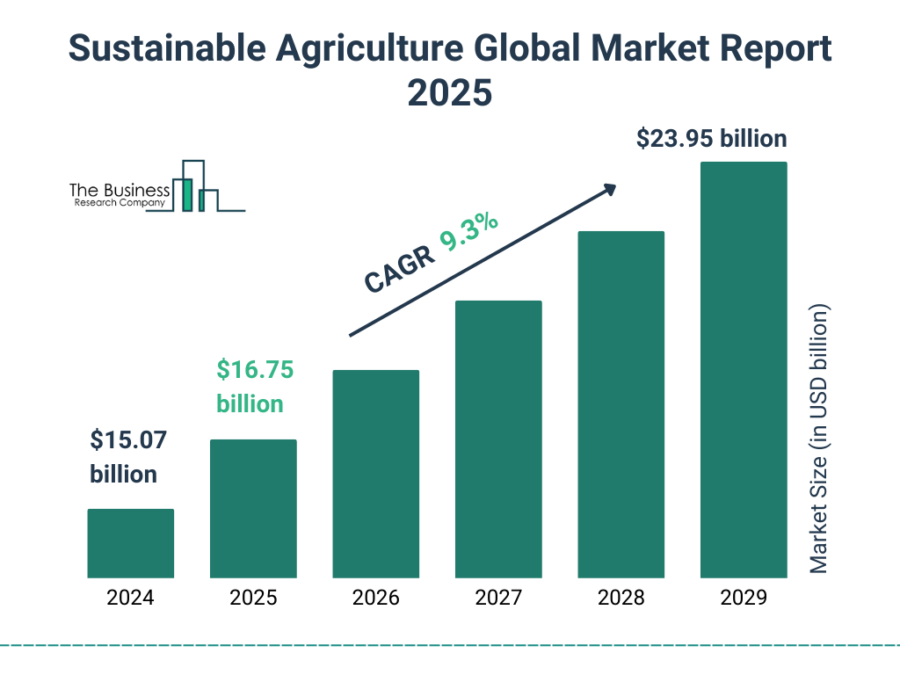
Source: The Business Research Company
- 2025: The Business Research Company expects the global sustainable farming market to reach USD 16.75 billion.
- 2025-2029:
- A CAGR of 9.3%.
- Sustainable farming market value to reach USD 23.95 billion by 2029.
Practical Use Cases of Sustainable Agriculture
- Integrated Pest Management (IPM): Combines biological, cultural, and mechanical practices to manage pests using natural predators, crop diversity, and habitat management to control pest populations and promote healthier ecosystems.
- Agroforestry: Integrates trees and shrubs into agricultural land to provide shade, reduce water evaporation, and improve soil fertility through nitrogen fixation. This also offers farmers additional income streams while sequestering carbon.
- Organic Farming: Natural inputs like compost, manure, and organic fertilizers maintain soil fertility and crop health while promoting biodiversity and soil structure. This also reduces pollution and ensures sustainable food production.
Core Technologies Connected to Sustainable Agriculture
- Precision Agriculture: Combines GPS, drones, sensors, and data analytics to monitor and manage crops at a micro-level. This approach allows farmers to apply water, fertilizers, and pesticides based on real-time soil health, weather conditions, and crop needs.
- Vertical Farming: Growing crops in stacked layers within controlled indoor environments using hydroponics, aeroponics, or aquaponics. This approach enables year-round cultivation and significantly reduces water usage.
- Genetic Engineering: Enables crops that are more resilient to pests, diseases, and changing climate conditions. Through genetic modification, scientists also create crops with enhanced nutritional content and reduced need for chemical inputs.
- Regenerative Agriculture: Restores soil health, enhances biodiversity, and improves ecosystem resilience through cover cropping, crop rotation, reduced tillage, and agroforestry. This approach improves soil carbon sequestration and water retention while reducing chemical inputs.
Noteworthy Sustainable Agriculture Advancements
- Syngenta: A global leader in agricultural science and technology that focuses on crop protection and seed development. Syngenta’s products include seeds, pesticides, and biofuels, all designed to support sustainable farming practices.
- Bayer: Through its subsidiary, The Climate Corporation, Bayer provides predictive AI for farmers. In rural India, their mobile app provides daily agronomic and location-specific insights to support smallholder farmers in crop protection.
- Taranis: Its precision agriculture intelligence platform leverages advanced computer vision, data science, and deep learning for field monitoring. The company partnered with Albo Climate to simplify carbon sequestration verification in farmland to expand carbon programs and enable farmers to enter carbon credit markets more easily.
Spotlighting an Innovator: alganize
German company alganize offers MIKROBIOM Farm, an algae-based biostimulant that enhances soil health and boosts sustainable agriculture. It enriches nutrient intake, enhances root growth, and promotes soil water retention by using metabolites from microalgae to stimulate beneficial microbial activity.
It also enables plants to develop a better immune system by establishing a healthy microbiome. This allows them to flourish in a variety of environmental conditions. alganize’s solution revives the soil and promotes regenerative agriculture to increase crop yields.
7. Water Conservation
Water conservation technologies are crucial for addressing the world’s growing water scarcity challenges, especially in regions facing drought or limited freshwater resources. These solutions include smart irrigation systems and water-efficient fixtures for wastewater recycling and desalination technologies.
Further, industries and households are able to monitor water usage, detect leaks, and optimize consumption leveraging IoT sensors and AI-driven analytics. As businesses are recognizing water as a critical resource, adopting conservation technologies becomes a strategic imperative for ensuring long-term sustainability.
Financial Forecast for Water Conservation Solutions
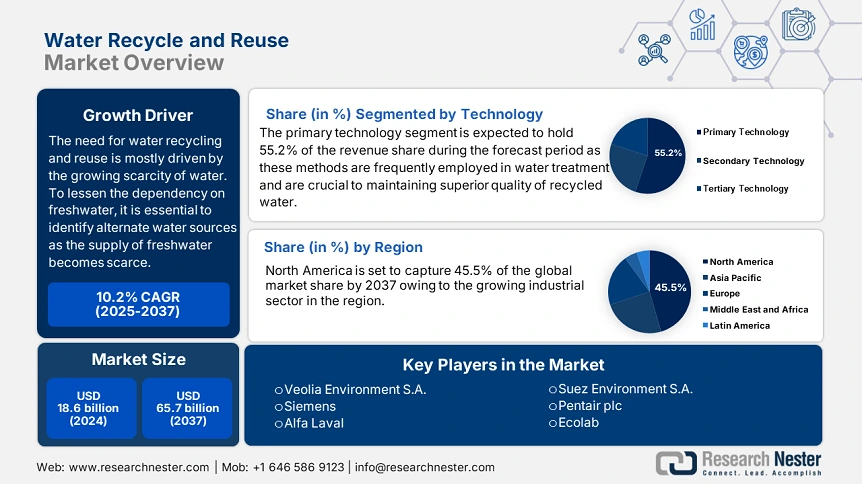
Source: Research Nester
- 2025: Research Nester forecasts the global water recycling and reuse market to reach USD 20.5 billion.
- 2025-2037:
- A CAGR of 10.2%.
- Water recycling and reuse market value to reach USD 65.7 billion by 2037.
Practical Use Cases of Water Conservation Technologies
- Greywater Recycling in Households: Involves collecting and reusing water from sinks, showers, washing machines, and other non-sewage sources for toilet flushing, landscape irrigation, or washing vehicles. This practice reduces the demand for freshwater.
- Xeriscaping: Designing gardens and green spaces using drought-resistant plants, native vegetation, and efficient irrigation methods significantly reduces the need for supplemental watering. This is suitable for arid and semi-arid regions.
- Rainwater Harvesting: Collects and stores rainwater from rooftops for non-potable uses like irrigation, toilet flushing, or washing. This reduces reliance on municipal water supplies, lowers water bills, and improves stormwater runoff management.
Core Technologies Connected to Water Conservation
- Desalination Technologies: Convert seawater into freshwater to provide a new source of drinking water in areas with limited freshwater resources. Reverse osmosis (RO), forward osmosis, and electrodialysis are making desalination more energy-efficient and cost-effective.
- Water Recycling and Reuse Systems: Treat wastewater from domestic, industrial, or agricultural sources using membrane filtration, ultraviolet (UV) disinfection, and advanced oxidation processes to remove contaminants from wastewater.
- Leak Detection and Monitoring: Utilizes sensors, IoT, and data analytics to identify and address leaks in water distribution networks. These systems continuously monitor pipelines to detect leaks in real time and alert maintenance teams to take corrective actions.
- Smart Irrigation Systems: Use sensors, weather data, and AI to monitor soil moisture, weather conditions, and crop needs in real time for delivering the precise amount of water required by plants. This reduces water wastage.
Noteworthy Water Conservation Advancements
- Ecolab: Its solutions allow businesses to optimize water usage while improving operational efficiency. As a founding member of the Water Resilience Coalition and the Alliance for Water Stewardship, Ecolab aims to restore more than 50% of its total water withdrawal by 2030.
- Xylem: The company promotes efficient water use through smart infrastructure solutions and digital technologies that enhance water management. Xylem’s technologies are used in municipal, industrial, commercial, and residential settings.
- D2K Information: Provides comprehensive water quality monitoring through its device, QualitEye. This device offers real-time data on water quality parameters, such as chlorine levels, pH, turbidity, temperature, and pressure.
Spotlighting an Innovator: Ecomemb
Ecomemb is a Spanish startup that provides sustainable reverse osmosis membrane regeneration technology that allows membrane reuse in water treatment processes.
The company refurbishes RO membranes to increase their lifespan and reduce chemical and water use using a proprietary energy-efficient process. In addition to saving money, this strategy diverts garbage away from landfills and promotes a circular economy.
8. Electric Vehicles
Electric vehicles offer a cleaner, more sustainable alternative to traditional gasoline-powered vehicles. They produce zero tailpipe emissions and significantly reduce greenhouse gas emissions and air pollution. Advances in battery technology, charging infrastructure, and vehicle design further make EVs more accessible and efficient.
This drives the widespread EV adoption across both consumer and commercial markets. Moreover, integrating EVs into business fleets and operations allows companies to reduce fuel costs and carbon footprints, aligning with sustainability goals.
Financial Forecast for Electric Vehicles
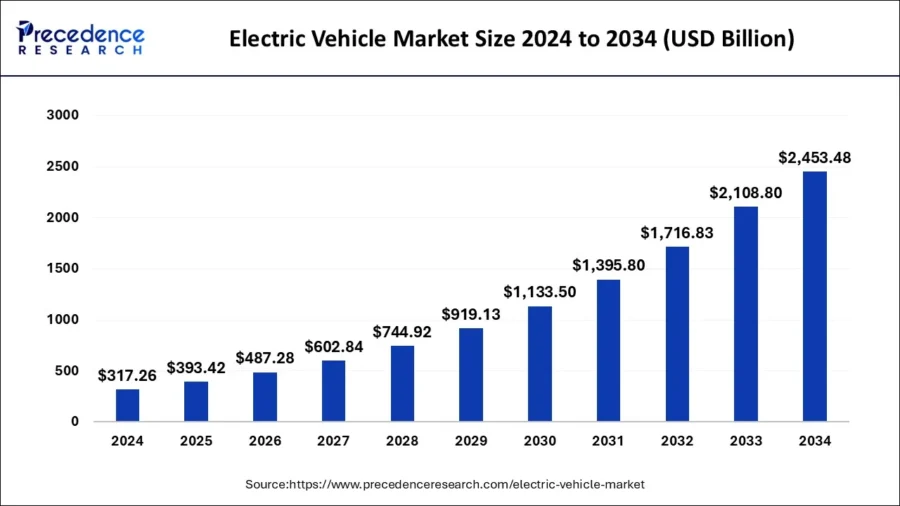
Source: Precedence Research
- 2025: Precedence Research predicts a global EV market to reach USD 393.42 billion.
- 2025-2034:
- A CAGR of 22.69%.
- EV market value to reach USD 2.45 trillion by 2034.
Practical Use Cases of Electric Vehicles
- Urban Public Transportation: Electric buses and taxis serve as eco-friendly alternatives to conventional diesel-powered vehicles in cities, reducing air pollution and noise levels. This leads to improved air quality and more sustainable urban environments.
- Last-Mile Delivery: Logistics companies use electric vans and bikes for last-mile delivery in densely populated areas. EVs offer lower fuel and maintenance costs. This makes them cost-effective for frequent, short-distance deliveries.
- Corporate Fleet Electrification: This shift enables companies to reduce their carbon footprint and fuel expenses. With government incentives and tax breaks for EV adoption, corporate fleets also benefit from long-term cost savings while supporting environmental goals.
Core Technologies Connected to Electric Vehicles
- Battery Technologies: Offer high energy density, long cycle life, and faster charging capabilities. Innovations in battery technology enhance storage capacity, reduce charging time, and improve overall lifespan.
- Electric Drivetrain Systems: Convert electrical energy stored in the battery into mechanical energy to power the vehicle. Unlike traditional internal combustion engines, electric drivetrains consist of fewer moving parts, making them more efficient and easier to maintain.
- Charging Infrastructure: Has a critical role in the widespread adoption of electric vehicles. Fast charging and wireless chargers are also emerging to reduce the time required to recharge and enhance user convenience.
- Advanced Connectivity: Enables communication between the vehicle, charging infrastructure, and the grid. This allows EVs to feed stored energy back into the grid during peak demand periods and facilitates real-time battery health monitoring.
Noteworthy EV Advancements
- Tesla: A leading innovator in the EV industry, known for its high-performance electric cars and commitment to sustainable energy. It manufactures battery electric vehicles (BEVs) like Model S, Model 3, Model X, Model Y, and the Cybertruck.
- BMW: Offers a range of fully electric models under its BMW i brand. It is committed to advancing electromobility and plans to generate more than half of its sales from electric vehicles by 2030. The company is also investing in innovative battery technologies.
- BYD: The company’s new energy vehicles (NEVs) include electric cars, buses, and trucks. BYD’s success is attributed to its comprehensive approach to EV manufacturing, which includes battery production and vehicle assembly, and surpassed Tesla in terms of market share in the first quarter of 2023.
Spotlighting an Innovator: Tresa Motors
Tresa Motors is an Indian company that manufactures high-performance electric trucks using an EV platform. The company’s axial flux motor, FLUX350, features a cold-rolled grain-oriented (CRGO) steel-based rotor with its crystal aligned to the magnetic flux direction. This reduces energy loss due to magnetic hysteresis and improves electricity conversion efficiency.
The motor also uses a dielectric liquid-based cooling system to operate at higher loads for extended periods. Further, Tresa Motors’ battery module, Meg50, features a self-enclosed design that uses a liquid as a heat transfer medium, which is also a lithium fire retardant.
These features allow trucking companies to transition to energy-efficient and cost-effective operations while promoting sustainable transportation.
The company recently secured a pre-order for 1000 electric trucks from JFK Transporters, a logistics company.
9. Green Computing
Green computing, or sustainable computing, focuses on designing, manufacturing, using, and disposing of computing devices and systems in an environmentally friendly manner. This approach emphasizes energy efficiency, resource conservation, and reducing electronic waste across the entire lifecycle of IT products.
Further, virtualization, energy-efficient data centers, cloud computing, and power management software enable businesses to minimize energy consumption and reduce costs.
With the growing demand for digital technologies and data processing, green computing practices are becoming crucial for organizations to enhance their sustainability credentials and ensure a sustainable digital future.
Financial Forecast for Green Computing
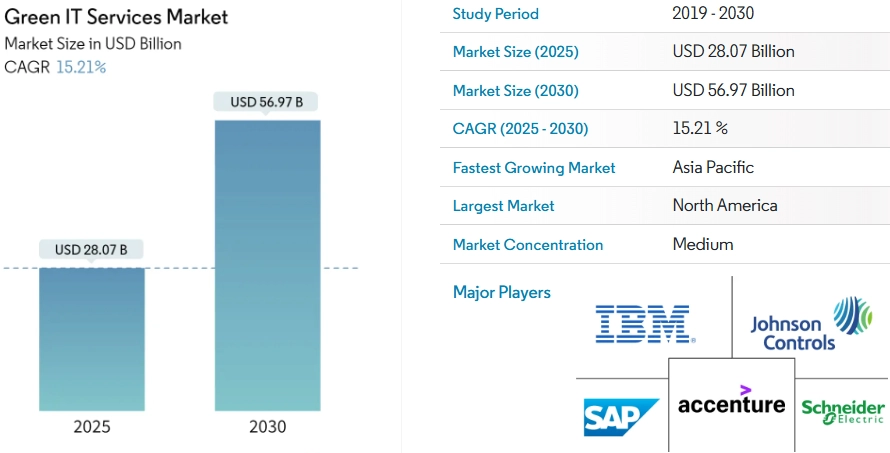
Source: Mordor Intelligence
- 2025: Mordor Intelligence predicts a global green IT services market to reach USD 28.07 billion.
- 2025-2030:
- A CAGR of 15.21%.
- Green IT services market value to reach USD 56.97 billion by 2030.
Practical Use Cases of Green Computing
- Energy-Efficient Data Centers: Advanced cooling systems, virtualization, and server consolidation reduce power consumption in data centers. By using liquid cooling, airflow management, and renewable energy sources, data centers minimize their carbon footprint.
- Paperless Office Solutions: Digital workflows, electronic document management systems, and e-signatures minimize paper usage in offices. This transition reduces the environmental impact associated with paper production, printing, and waste.
- E-Waste Recycling Programs: Responsibly dispose of or repurpose outdated hardware. Refurbishing, recycling, or safely extracting valuable components like metals and plastics from discarded electronics reduces the environmental impact of electronic waste and supports a circular economy.
Core Technologies Connected to Green Computing
- Energy-Efficient Hardware: Modern energy-efficient CPUs and GPUs utilize advanced architectures that reduce energy consumption by managing power dynamically based on workload demands. For example, neuromorphic computing and solid-state drives (SSDs).
- Virtualization and Cloud Computing: Virtualization allows multiple virtual machines (VMs) to run on a single physical server to reduce the need for additional hardware. Cloud computing further enhances this efficiency by offering scalable, on-demand access to computing resources.
- Edge Computing: Reduces the need for long-distance data transmission by processing data closer to its source. This significantly reduces energy consumption while reducing latency, making it suitable for applications that require real-time data processing.
- Renewable Energy Integration: Solar, wind, and hydroelectric power allow data centers and computing infrastructures to reduce reliance on fossil fuels and minimize greenhouse gas emissions. For instance, powering servers, cooling systems, and GPUs with solar energy.
Noteworthy Sustainable Computing Advancements
- Dell Technologies: Focuses on reducing its carbon footprint by using recyclable materials and implementing a circular approach to product design. Dell’s Latitude 5000 series laptops, for example, are made from 71% recyclable materials, including bioplastics and ocean-bound plastics.
- Apple: With its commitment to achieving carbon neutrality by 2030, the company has significantly reduced its carbon emissions by over 45% since 2015 through renewable energy initiatives and low-carbon product designs.
- IBM: The company aims to achieve net-zero greenhouse gas emissions by 2030 and has implemented numerous conservation projects to save energy and reduce CO2 emissions. IBM also invests in R&D of energy-efficient chips and heterogenous structures that optimize power usage.
Spotlighting an Innovator: Deep Green

Deep Green is a UK-based company that offers waste heat recovery by capturing and repurposing excess heat generated by its edge data centers. The company’s data furnace technology is a miniaturized data center that generates heat during operations.
This heat is recaptured and runs through a heat exchanger to deliver heat for swimming pools and district heating systems. The company’s solution delivers high-performance computing (HPC) with less energy than conventional data centers while providing free hot water to facilities.
The startup also received a USD 249 million investment from Octopus Energy, an energy provider, to scale its technology to 150 sites across the UK.
10. Waste-to-Energy Technologies
Waste-to-energy technologies convert non-recyclable waste materials into electricity, heat, or fuel through processes like combustion, gasification, and anaerobic digestion. By diverting waste from landfills and reducing methane emissions, WTE systems mitigate environmental pollution and create a valuable energy source.
As waste generation continues to rise, WTE technologies provide a sustainable way to address waste management challenges. Adopting WTE solutions further allows businesses to align with circular economy principles and generate additional revenue.
Financial Forecast for Waste-to-Energy Technologies
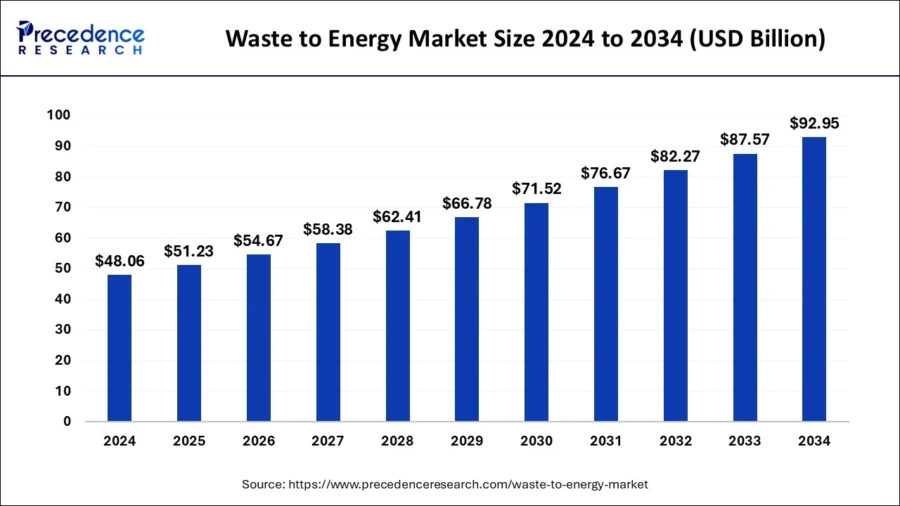
Source: Precedence Research
- 2025: Precedence Research predicts a global waste to energy investment of USD 51.23 billion.
- 2025-2034:
- A CAGR of 6.18%.
- Waste to energy market value to reach USD 92.95 billion by 2034.
Practical Use Cases of Waste-to-Energy Technologies
- Urban Waste Management: Waste-to-energy plants reduce the volume of waste that ends up in landfills to decrease the pressure on waste disposal sites and emissions from decomposing waste. The electricity and heat generated are supplied to nearby communities.
- Agricultural Residue Utilization: WTE solutions process crop residues, animal manure, and other organic by-products into biogas or bioenergy. Anaerobic digestion, for instance, allows farmers to convert organic waste into energy that can power farm equipment and heat greenhouses.
- Industrial Waste Conversion: Plastics, rubber, or chemical by-products are converted into energy or raw materials using gasification and pyrolysis. This approach reduces waste sent to landfills and provides an alternative energy source.
Core Technologies Connected to Waste-to-Energy
- Incineration with Energy Recovery: Involves the combustion of waste materials at high temperatures. This process reduces waste volume significantly and converts it into heat energy, which then produces steam. The steam drives turbines to generate electricity or provide district heating.
- Anaerobic Digestion: A biological process that breaks down organic waste materials, such as food waste, agricultural residues, and sewage sludge, in the absence of oxygen to produce biogas. It finds use in heating, electricity generation, or as a fuel for vehicles.
- Gasification: Converts waste materials into syngas by exposing them to high temperatures in a controlled oxygen environment. Unlike incineration, gasification does not involve complete combustion, resulting in lower emissions and cleaner energy output.
- Pyrolysis: Heating waste materials in the absence of oxygen breaks them down into smaller molecular components. This process produces pyrolysis oil, syngas, and char, all of which are used as energy sources. Pyrolysis is particularly effective for converting plastic waste, tires, and biomass into fuel.
Noteworthy WTE Advancements
- Veolia: Operates numerous facilities worldwide that convert waste into renewable energy. These facilities use advanced technologies to process municipal solid waste and industrial waste, transforming it into electricity, steam, or heat.
- Babcock & Wilcox: Offers a range of services including the design, supply, and operation of WtE plants. Its solutions include advanced boilers, combustion grates, and emissions control systems that ensure efficient energy recovery.
- Reworld: Operates 40 plants across North America and Europe. These facilities convert millions of tons of waste into clean energy annually. Covanta’s WtE plants reduce landfill dependency and generate electricity by combusting municipal solid waste.
Spotlighting an Innovator: Syn X Energy
Australian startup Syn X Energy provides waste-to-energy technology using high-temperature gasification. It converts waste into valuable products such as sustainable aviation fuel (SAF), renewable diesel, hydrogen, methanol, and electricity.
Operating at temperatures above 1650°C, its proprietary gasification process efficiently converts a variety of waste kinds into energy-rich outputs while reducing pollutants and the need for landfill space. By upcycling garbage into sustainable energy, this solution promotes a circular economy and manages waste in an environmentally responsible manner.
Overcoming Challenges in Implementing Sustainable Business Strategies
Organizations are able to improve long-term profitability, spur innovation, and revolutionize operations by integrating sustainable technologies into their workflows. However, this can present a number of difficulties for businesses. To successfully implement sustainable practices and achieve desired outcomes, here are a few issues you can look out for:
Initial Investment
The high upfront costs of integrating sustainable strategies are the most critical challenge for businesses. For instance, implementing on-site renewable energy sources or reorganizing supply chains demands large capital expenses.
However, businesses must understand the long-term ROI that sustainability offers, even though these costs may seem high. Sustainable techniques eventually result in reduced energy and operating costs while increasing resource efficiency. Businesses also leverage financial incentives, government subsidies, or green financing to offset these upfront costs.
Regulatory Compliance
Navigating the complex web of sustainability regulations and laws is another challenge for businesses. Moreover, differences in energy efficiency standards, waste management plans, and emission reduction targets across geographical areas affect businesses that operate in multiple industries or regions.
Therefore, companies should keep up with changing rules and actively interact with trade associations, legislators, and sustainability specialists to overcome this obstacle. They can also leverage tech-driven solutions, like emissions reporting platforms, regulations monitoring software, and carbon capture systems, to ensure that their operations follow sustainability regulations.
Measuring Impact
It is essential to measure the impact of sustainability programs to track advancement, establish their worth, and pinpoint areas that require improvement. However, choosing the appropriate measurements, methodologies, and instruments to assess sustainability performance is difficult for a lot of companies.
For this, businesses can use standardized measurement frameworks like those offered by the Sustainability Accounting Standards Board (SASB) and the Global Reporting Initiative (GRI). By helping businesses set specific objectives, track their progress, and share their successes with relevant parties, these frameworks improve accountability and transparency.
The Future of Green Technology for Businesses
Evolving Consumer Expectations
The future of sustainability in business will be shaped by the increasing consumer demand for climate-positive products and services. This will drive companies to incorporate sustainable solutions and adopt more environmentally friendly practices.
Businesses that put sustainability first will satisfy customers and also obtain a competitive edge that will increase market share and brand loyalty. The emergence of renewable energy-powered appliances and electric vehicles (EVs) is an example of how changing customer preferences advance the implementation of environmentally friendly technologies.
The Rise of Green Technologies
Advanced battery storage systems, hydrogen fuel cells, and smart grid infrastructure are examples of technologies that will improve energy efficiency while lowering carbon emissions. Additionally, artificial intelligence, IoT, and more will enable intelligent resource management, predictive maintenance, and optimum energy use.
For example, AI-driven energy management systems forecast patterns in energy use to instantly optimize consumption. This reduces energy waste while lowering operating expenses.
Regulatory Shifts
Governments are implementing stricter environmental laws to tackle pollution, resource depletion, and climate change. Businesses must adhere to new emissions, waste management, and energy efficiency rules, which will accelerate the adoption of green technologies.
Regulations related to the circular economy, carbon pricing, and incentives for renewable energy will encourage businesses to invest further in sustainable practices. For instance, the European Union’s Green Deal requires enterprises to embrace green technologies and lower their carbon footprints in order to achieve the region’s goal of being climate-neutral by 2050.
Act Now To Stay Ahead of the Green Technology Curve
Staying competitive means more than just being aware of technological advancements in sustainability. Every industry faces unique challenges and opportunities in implementing sustainable solutions, and a one-size-fits-all approach isn’t enough.
That’s where our AI and Big Data-powered Discovery Platform comes in. With access to over 4.7 million emerging companies and 20K+ tech trends globally, it equips you with the actionable insights you need to stay ahead of the cleantech curve. Leverage this powerful tool to spot the next big thing in sustainability before it goes mainstream. Stay relevant, resilient, and ready for what’s next.

